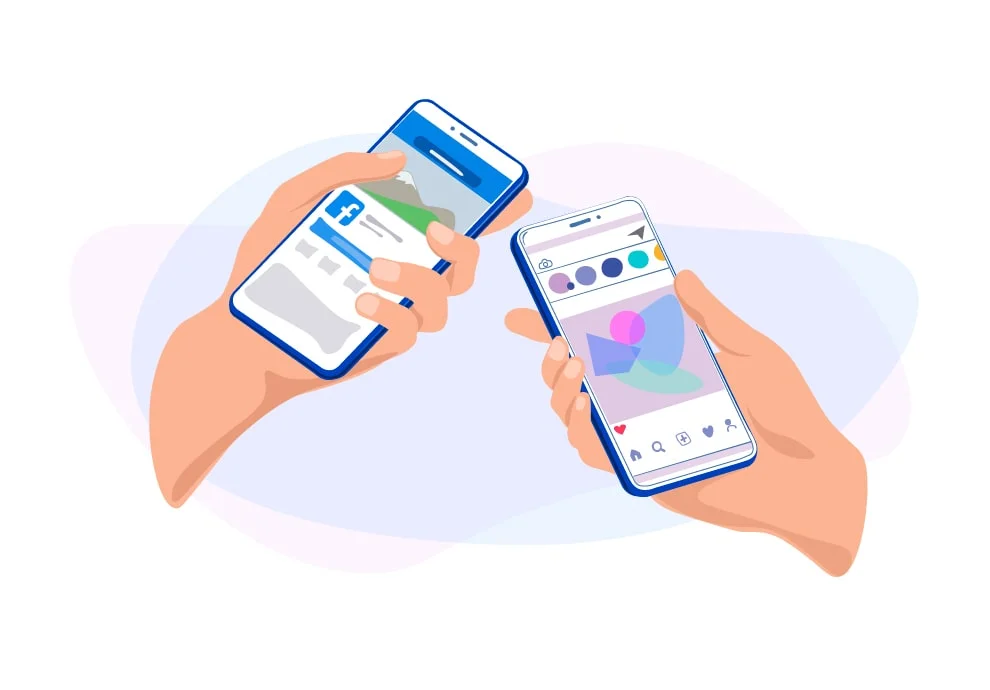Let’s discuss the difference between running a blog on Instagram and Facebook, as each social network has its own rules and peculiarities.
Audiences on Instagram and Facebook
The Instagram audience is spoiled by giveaways and presents. Everyone wants to receive a big prize for following an account.
The audience on Facebook is more judgmental and conscious than on Instagram.
Almost every second user on Instagram dreams of becoming a blogger. They want to make money with the help of their blog and aim at monetizing their account.
On Facebook, the situation is different. People don’t write posts to attract new audiences but to share a point of view. People write for themselves and leave notes as personal memories. Business offers are also quite common on Facebook: “I am looking for a specialist, “Could you please share your contact details?”, “The terms are…”. You can even find a job on Facebook.
You can only grow organically on Facebook: there are no fake likes, giveaways, or special services that drive the numbers up. That is why the number of likes on Facebook is ten times lower than on Instagram. Besides, it is harder to increase the number of followers on Facebook. Quite often, Instagram bloggers are trying to repeat their success on Facebook, but it does not work because they cannot attract audiences.

What makes posts on Facebook different from those on Instagram
Visual content matters the most on Instagram.
Facebook is all about content: the texts you write, the jokes you make, and the stories you share. The image may not be the greatest, but the impressive text sells it. People enjoy reading, even if it is a long read that tells an engaging story or gives a piece of advice. The Facebook audience is very receptive and appreciates literacy. On Instagram, it doesn’t matter so much.
There are no limits on Facebook: the texts can be as long as you want. If you publish the same text on Instagram, it won’t fit. You’ll have to write a part of the text in the comments or add screenshots to the carousel.
Photos don’t matter much on Facebook. You can even make posts without any visual content as long as you are good at writing catchy texts.
Different approach to promotion on Instagram and Facebook
On Facebook, unlike on Instagram, people still show genuine reciprocal interest. On Instagram, user interactions may sometimes be unemotional and indifferent. For example, it is quite common to give a like for like. Or you can leave a comment: “The weather is so nice!” and receive an relevant reply.
If you visit someone’s page on Facebook, like their posts, and interact with their content, quite often, this genuine interest will result in the other person following you, giving you likes, and writing comments. People go on viewing your posts later on. The key rule to increasing the audience on Facebook is posting engaging and qualitative content. On Instagram, however, it is not only qualitative content that matters.
On Facebook, even the most amazing post won’t be shown to people who are not following you, just because there is no separate ‘Explore’ section. However, if a user comments on a post, all their friends get a notification. They can read the post, potentially give likes, and follow you.
Brand advertising on Instagram and Facebook
On Facebook, there is a clear division between advertising and non-commercial posts. Advertising on Facebook can easily undermine a blogger’s image. On Instagram, advertising is not frowned upon; you can openly write that it is an advertising post and you sell something.
When advertisers open a page and analyze a profile on Facebook, they look at the comments. If they see comments left by other bloggers, they may think that it is a fake blog. They can, however, be wrong.
The main advertisers on Facebook are big companies that know how to promote their brand on Instagram but want to reach different audiences on Facebook. When things work well for a brand on Instagram, they understand that it’s time to target audiences on Facebook because the users there are different and more thoughtful. So, companies are looking for bloggers in their field and are ready to pay for advertising.
The disadvantage of Facebook is that you can’t see the statistics of a personal account. Only a person who understands how Facebook works can see if the page is genuinely popular. It is impossible to drive the numbers up, so you need to look at the real comments.
As a result, potential advertisers look at likes and comments to see how active the page is.
3.000 followers will be enough for advertisers to pay attention to your Facebook page and offer a contract. On Instagram, 3.000 followers are not enough.





